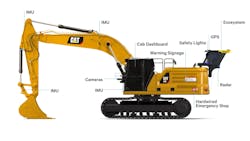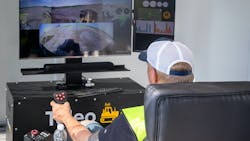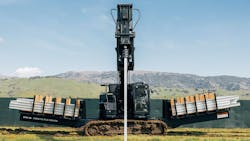Automation in off-highway equipment has gone beyond Australian, South American, and American Southwest mining to conventional job sites in familiar places such as California, Florida, and Canada.
And the use of autonomous and remote-control equipment is only going to spread.
North America is one of the major off-highway automation hubs, with several pilots in place and a degree of commercial adoption that has attracted autonomous solution providers, startups, and suppliers to cater to customer bases in mining, and urban construction.
Read more: The Case for Remote Control in Construction
With a total off-highway equipment volume (in operation) of approximately 7.9 million units, the United States holds strong potential to become a global leader in terms of the autonomous equipment market.
Although the U.S. stakeholders across all off-highway application areas (including construction, mining, and agriculture) are expected to ramp up the adoption of autonomous solutions, Canada is expected to become a key target market for autonomous mining solutions.
Here in the U.S., much of the latest action that has reached jobs sites has come from companies that retrofit existing equipment.
Companies such as Teleo, Built Robotics, and Safe AI have developed brand-agnostic systems that allow remote control or autonomous operation of dozers, excavators, pile drivers, and ADTs, to name a few. There doesn’t seem to be much of a limit to machine categories or size.
He foresees the company’s remote-control use growing.
“The next step is having one batch plant operator and one loader operator operating multiple plants, where they’re just teleporting over the internet to different machines and batch seats to make the concrete,” Aarts said.
Global Growth in Autonomous
In its report, "Growth Opportunities in the North American Autonomous Off-highway and Agricultural Robotics Equipment Industry," the firm Research and Markets points out the speed with which autonomy is growing.
The automation of off-highway equipment has experienced rapid development in the past 3 years, according to the report. Globally, the total amount of autonomous off-highway equipment in operation more than doubled to reach approximately 1,700 units in 2022, from approximately 800 in 2021.
As the demand for process automation increases in construction and agriculture, Research and Markets’ analyst expects increasing adoption of autonomous equipment starting with smaller machinery segments in the short term, and later leaning into larger machinery.
Teleo may be the most publicized of the lot. It has several contractors currently using machines in the field. In Canada, it worked with the John Aarts Group to retrofit a John Deere 624K wheel loader for a remote ready mix plant-loading operation in Tillsonburg, Ontario.
Since Tillsonburg is a slower plant, with one operator doing multiple jobs at the site, loading the hopper remotely frees the operator to switch to other tasks instead of spending time in an idling loader or physically moving to another machine.
“It’s rather obvious when you can take an operator out of the seat,” said Ryan Aarts, CEO of the John Aarts Group. “This is something that impacts our health and safety. We have people that hurt their back and then they can’t work. With Teleo, you have the opportunity to actually put them in a much safer, secure environment. This opens the door for the types of people that can do this work,” Aarts said.
In California, Teichert, a construction and materials company, has worked with Teleo to retrofit two crawler dozers, a Caterpillar D10T and D10T2. The second machine is at work at the company’s sand and gravel mine near Tracy, California.
The Teleo system is designed to operate day and night. The machine is used to remotely push sand and gravel to an on-site processing plant. The materials produced at the plant are used in asphalt, concrete, and infrastructure projects throughout the California Central Valley and Bay Area. The remote operations capability is a significant value-add for customers, as it increases operator safety while improving productivity, Teichert said in a statment. These benefits will continue to grow as more Teichert machines are retrofitted with Teleo’s technology.
“We believe Teleo’s technology can help a good operator become a great operator,” said Dan Campbell, head of engineering for Teichert Materials. “The technology will improve the operator experience, making the job safer and more comfortable for our team members. The central command center also makes it easier for operators to go on breaks and creates a seamless and efficient transition between shifts.”
Another autonomous capability is tramming, or autonomous hauling materials from one point to another. Tomahawk Construction, of Ft. Myers, Florida is using Teleo-equipped articulated dump trucks for autonomous tramming across a Naples, Florida, job site to move material for a a residential community.
Operators driving dump trucks spend the majority of their time tramming from one point to another. By automating the tramming portion, one operator can run multiple machines simultaneously, multiplying their productivity. The physical dumping of materials will be handled remotely by one operator controlling multiple machines from a comfortable command center.
Read also: Bigger Is Not Better with Autonomous Haulers
"Teleo's technology has the potential to completely transform our operations," said Scott Lyons, managing member, Tomahawk Construction. "With Teleo, two of our dump trucks that have been idle have been put back into service to haul dirt across the site autonomously, allowing our remote operators to do more. This helps us to run a more efficient operation."
Ajax Paving of Ft. Myers, Florida, will have two Caterpillar wheel loaders with Teleo's technology. These loaders are to be stationed at two of the company's asphalt manufacturing plants to load the bins at the plant. The plants are roughly 80 miles apart, marking the first time one operator will work across two job sites.
"The asphalt industry operates on tight schedules," said Andy DeCraene, VP, Ajax Paving. "When our customers require asphalt, we must deliver promptly, making it imperative for our machines and operators to remain available. Allowing one operator to control machines at multiple sites is a significant advantage. If an operator is unavailable at one site, another can operate the machine remotely. This is a genuine game changer for our business."
Ben Harlan, field technology manager for Ajax, says the first Cat 966 is fully functional. "They're making tweaks to it; it's semi-autonomous now," Harlan said. "It will operate for a month or so in 'tracking' mode, and eventually we'll be able to tell it to go to bin one, and so forth, then send it back to the plant remotely. It will probably be two years before it's fully autonomous.
"In the construction industry, there's resistance to change on anything," Harlan says. "One day, operators are resistant, the next they're excited about it. I ran it and it was actually really cool--and I used to be an operator."
Built Robotics offers two systems that bring autonomous tech to off-road iron.
The RPD 35 combines four steps, layout, pile distribution, pile driving, and as-builts, into a single robotic pile driver. A custom-engineered hammer working at 500 blows per minute, up to 24 hours a day, puts pile in the ground.
A sled carrying system speeds pile distribution. The sleds on the RPD 35 can carry payloads of 22,000 pounds, and up to 192 piles. Built says the sleds unlock new productivity gains not possible with existing pile distribution methods.
\The Built Exosystem is designed for excavators from 15 to 50 tons to enable them to operate autonomously. The system includes an all-weather enclosure, proximity radar, 360-degree cameras, GPS, and a liquid-cooled computer.
Built says its system features state-of-the-art RTK, GPS, and IMUs and proprietary kinematic software.
The mounting system goes on the tail of the excavator and can be detached when needed. Cameras, and other sensors, are mounted with magnets and U-clamps. Installation takes a few hours and is fully reversible, the company says. Mounting hardware is built in to allow the unit to be lifted with service trucks, forklifts, and other excavators.
Finally, the system preserves the availability of manual operation of the machine, including rear-view backup cameras and native controls.
Safe AI, another autonomous provider, has just started a pilot program with CRH Ventures, a subsidiary of global building materials company CRH PLC. The pilot program aims to evaluate the feasibility and capabilities of SafeAI’s technology for autonomous operations in quarrying.
SafeAI’s retrofit solution utilizes imaging, detection, and positioning technologies with Artificial Intelligence to enable heavy off-road hauling vehicles to operate autonomously. CRH Ventures has engaged SafeAI for a pilot program at one of its prominent quarrying subsidiaries in North America. The autonomous truck, equipped with SafeAI’s technologies, will operate in an isolated area under the supervision of a test driver.
"This pilot program with SafeAI aligns with our commitment to explore innovative solutions for more efficient and sustainable quarrying operations," said Eduardo Gomez, head of CRH Ventures, in a statement. "We are excited to assess the potential of autonomous hauling technology in a controlled environment and the possibilities for future scaling."
The pilot program is designed to simulate quarry operations and will run for approximately one year. The success of the initiative will be evaluated based on predetermined Key Performance Indicators (KPIs) over various test scenarios, comparing autonomous performance against traditionally manned operations.
“While this marks an important step in our exploration of autonomous hauling solutions, it’s crucial to clarify that, at this stage, CRH Ventures is focusing on piloting the technology before finalizing any strategic investments,” Gomez said.
In Japan, Safe AI has worked with heavy civil firm Obayashi on retrofitting a Caterpillar 725 ADT. Obayashi believes that by 2030 all construction equipment will be autonomous in Japan and the civil engineering process will be directed from a comfortable office.
About the Author
Frank Raczon
Raczon’s writing career spans nearly 25 years, including magazine publishing and public relations work with some of the industry’s major equipment manufacturers. He has won numerous awards in his career, including nods from the Construction Writers Association, the Association of Equipment Manufacturers, and BtoB magazine. He is responsible for the magazine's Buying Files.



